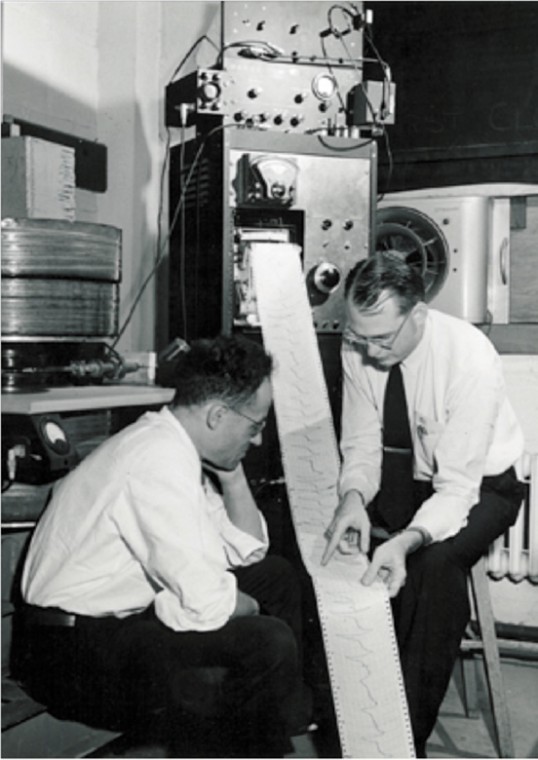Washington U’s Manhattan Project braintrust
Published May 16, 2012
Samtuel “Sam” Isaac Weissman, Ph.D., who died at 94 in 2007, was one of the six founders of the modern chemistry department at Washington University. All six were veterans of the Manhattan Project, which led to the assembling of the atomic bombs used in 1945 that resulted in the Japanese surrender. Spring 2012 marks the 100th birthday of Weissman, and to celebrate the occasion, the Washington University Department of Chemistry hosted a poster session, lecture and symposium in his honor last week.
Weissman’s career is described as “inextricably entwined with the history of the chemistry department at Washington University.” That history is illustrated by portraits of Weissman and his five co-founders of chemistry department that are mounted in the Rattner Gallery of the Lab Sciences building on the university’s Danforth Campus. The captions for each portrait was written by emeritus professor of chemistry Alfred M. Holtzer, Ph.D., who was a student of five of the six founders before becoming a fellow scientist and their colleague.
Holtzer wrote, “Just after World War II, the Washington University chemistry department was comprised of only three members, none active in research. The Board of Trustees decided to raise the university’s scholarly level to include research as well as teaching. To that end, they appointed physics Nobel Laureate Arthur Holly Compton, a former Washington U. faculty member, as Chancellor.
“Compton had been an important figure in the Manhattan Project that created the atomic bomb. In 1946, he recruited to Washington U. from the Los Alamos campus of the Manhattan Project the six chemists whose portraits are hung in the Rattner Gallery. They brought with them from Los Alamos, not only outstanding scientific gifts,” Holtzer continued, “but also a spirit and an attitude, featuring irreverence toward entrenched authority, fierce devotion to academic freedom, uncompromising intellectual honesty and a love of science that soon pervaded the atmosphere. Together, the six created the modern teacher-scientist Chemistry Department that still flourishes at Washington U. today.”
Weissman was educated in Chicago’s public schools. He earned his bachelor’s and doctoral degrees in physical chemistry at the University of Chicago. He then moved to the University of California-Berkeley to work in the laboratory of Gilbert Newton Lewis (familiar to chemistry students everywhere as the author of the Lewis dot diagram shorthand used to figure out the bonds between atoms in molecules). Lewis later studied the optical properties of rare earth metals, laying the foundation for certain lasers.
During 1942 and 1943 Weissman worked on isotope separation needed to prepare fissionable material for a uranium bomb at Berkeley’s Radiation Laboratory. He moved to Los Alamos in 1943, where he was a group leader in the Manhattan Project and worked on the design of a plutonium bomb.
Weissman and his five colleagues (surviving members of the Manhattan Project team) discussed their concerns and ambivalence about the project in an article that ran in Washington University’s magazine. They were under the impression that the German bomb program was quite advanced and were shocked when they later learned how little progress the Germans had actually made. At the same time, they were also aware that fighting island to island in the South Pacific was taking a horrific toll in lives.
Each of the interviewed scientists expressed misgivings, perhaps Weissman more than the others. “I think we would all have been relieved if it had been demonstrated that it couldn’t possibly work,” he said of the bomb.
Not everything about Weissman was as grim and serious as his work on the Manhattan Project. Holtzer recalls that “with Sam you gained insight, but you could also die laughing.” Weissman was the son and grandson of Yiddish storytellers and a storyteller himself who told many such stories about his family and growing up in Chicago.
One story is still told by Weissman’s son Michael: “One time when the rabbi was out, Sam’s mischievous Zadie (Grandfather) Benjamin persuaded the old codgers hanging out at the synagogue that false teeth counted as eating implements. Therefore one needed separate sets of teeth for milkig (dairy products) and fleishig (meat products). The only way to purify a contaminated set was to bury it for 60 days. They were busy digging holes when the rabbi returned and put a stop to it.”
The recurring refrain from testimonials from Sam Weissman’s friends and colleagues was that he was a man of integrity. C. Alden Mead, a former student in 1966 wrote, “Sam’s character is marked by a refreshing honesty and humility, a fine sense of humor, a complete contempt for all humbug, together with an ability to recognize it, and in general a warm humanity. In short, he is one of the finest human beings I know.”
You might say that Sam Weissman was a Manhattan Project maven, a chemistry pioneer at Washington U. and in the language of his sense of humor, a real mensch!















